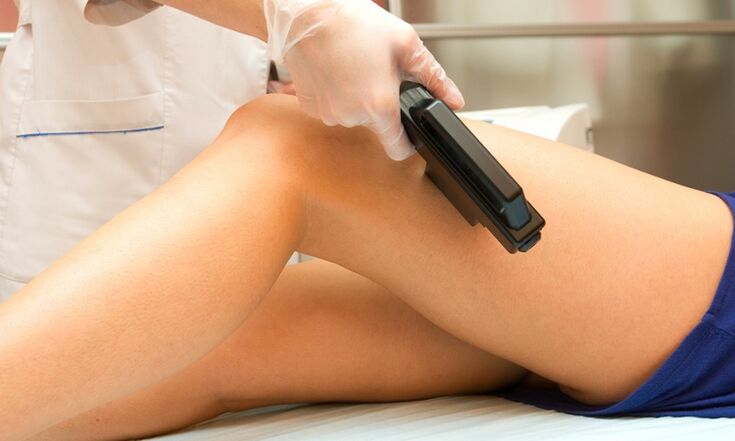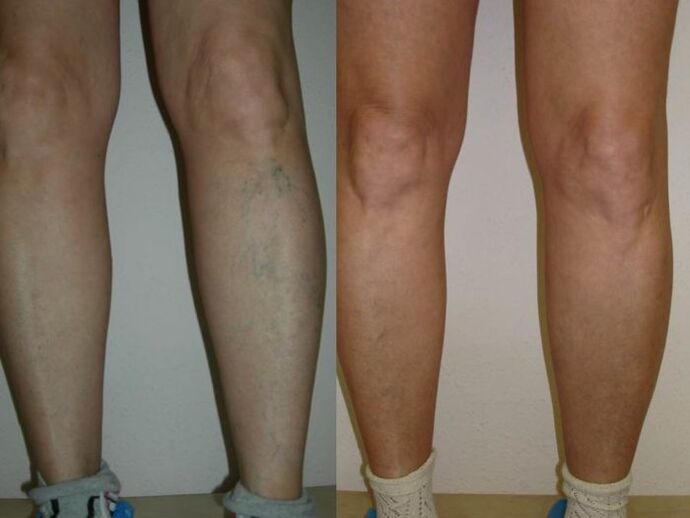Varicose veins in the legs are a common pathology that occurs in people of different sexes and ages, regardless of the country of residence. For a long time, dilated veins in the lower extremities could only be removed with surgery. But today, doctors offer a painless and effective method - laser treatment of varicose veins.
The essence of the procedure lies in the introduction of a special light guide into the blood vessels, which causes the damaged vessel to stick together and direct blood flow through healthy veins. If you are considering alternative therapies, you will:
- classic removal of veins (phlebectomy) is characterized by pain and trauma, there is a risk of infectious complications;
- removal of only part of the patient's vein (microflebectomy) leaves scars on the skin;
- sclerotherapy causes allergies in some cases.
Considering the disadvantages listed, which are missing from the laser, laser treatment of varicose veins is rightly called the best solution out of the existing ones. Doctors have been using this method for more than 10 years, during which time laser coagulation has not caused any complaints. Not everyone can afford the price, but given the efficiency of the process, it is entirely possible to accumulate the necessary amount or take out a loan.
Indications for laser coagulation
The procedure is recommended in the presence of dilated large and small saphenous veins. In addition, the dilation of the vascular system should not exceed 1 cm, and the veins themselves should be mostly uniform without sharp bends. The branches of the veins should be healthy or slightly dilated. In other words, laser coagulation is effective in the early stages of varicose veins when the severity of the veins is low, and this only applies to superficial veins. As for veins dilated by more than 1 cm, they can also be "glued" with a laser, but there is a risk that the vessel will become stuck again in the future and all treatments will be wasted.

The laser acts on a small area, which eliminates the negative effect on adjacent tissues. For this reason, the laser is not effective for significant vascular damage and deep veins. In such situations, choose one of the classic methods listed above.
Contraindications to laser treatment
In addition to the cases listed above, when the technique becomes ineffective, endovascular laser coagulation of varicose veins is contraindicated in situations where it could harm the patient. There are quite a few contraindications, and each falls into a relative and absolute category.
Relatives include contraindications that only currently do not allow surgery to be performed. This can include burns and inflammation of the skin, exacerbation of chronic pathologies. The current problem should be corrected and then laser removal of the veins should be continued. If you do the opposite, there is a high risk of complications. Pregnancy and hepatitis B are also relatively contraindicated, as the body weakens during this period and the load on the legs is high. Due to congestion in the veins of the lower extremities, surgery is not performed in obese people - complications are likely.
Absolute contraindications include contraindications that prevent a person from having laser removal. These conditions are:
- damage to the walls of the blood vessels;
- disturbed lymph and blood flow in the legs;
- thrombophlebitis and predisposition to thrombosis.
Underlying these conditions, laser can cause venous thrombosis and damage to blood vessels. Other contraindications are related to people’s lifestyles - if it is not possible to move actively and wear compression underwear in the future (after surgery), the blood vessel may become inflamed and the treatment will be ineffective.
How the procedure works
Laser varicose veins are treated on an outpatient basis. General and local anesthesia is not required because the area of effect is very small and the process takes place inside the vessel. If necessary, you can take a sedative if you are afraid of surgery. The essence of the procedure:
- a small incision is made in the skin of the foot through which a light guide is inserted into the injured vein. This luminaire emits laser light at a controlled wavelength;
- the radiation displaces the blood from the damaged vein;
- the laser causes the walls of the vessel to stick together, and the blood no longer circulates here.
Laser treatment usually lasts 90 minutes. After the damaged veins are closed, the blood is directed through deep veins inside the muscles. There are no scars or hematomas after such a procedure.
Benefits of laser therapy
As mentioned at the beginning of this article, compared to other methods, laser reversal has several advantages. Everyone needs to know about the main benefits:
- you do not have to go to the hospital because the procedure is performed on an outpatient basis, you can go home on the same day;
- the procedure gives the best cosmetic effect, as the doctor reaches the affected vein with a small puncture on the skin, which later heals without scars and scars;
- modern laser equipment scatters radiation well, allowing good quality treatment inside the vessel. This eliminates the risk of bleeding and bruising;
- it is possible to remove the veins on both legs immediately;
- the rehabilitation period is very fast and painless. An hour after the procedure, you can go home and live the same life in a few days.

Considering the listed advantages of the procedure, it becomes clear why the treatment of varicose veins with laser coagulation is considered to be the most effective and safest. There is no thrombophlebitis and no secondary infection, no scars or discomfort, no complications or relapses afterwards.
Disadvantages of Laser Vein Treatment
There are both pros and cons to any medical manipulation. When removing the veins in the legs, the laser treatment is not always cloudless either. More specifically, before the procedure, you should become familiar with the possible difficulties and disadvantages of the technique:
- the severe stage of varicose veins is not treated with laser;
- with the large diameter of the damaged vessel, laser therapy is combined with surgery and no incisions or skin marks can be left;
- laser treatment of varicose veins involves wearing compression stockings (at least) a week after surgery, which not everyone likes;
- The main disadvantage is considered by many to be the high cost of laser procedures.
After considering the advantages and disadvantages listed, you can discuss with your doctor how best to treat varicose veins in a given case.
Rehabilitation
There are no special measures to restore health after laser coagulation of veins. The patient quickly returns to normal life. No hospitalization is required, as is bed rest. The same can be said for taking antibiotics, physiotherapy procedures, and tightly tied legs like a mummy - the modern procedure is completely free of these shortcomings.
At the end of the surgery, the doctor will allow the patient to rise gradually. You must first sit on the couch for a while to normalize your condition and then you can get up. After an hour of lying down, a sharp rise is not recommended because of vasoconstriction, dizziness, etc.
The patient does not feel any pain in his leg when he transfers his weight to them. The only thing that might bother you is the slight tingling sensation in the part of the foot through which the light guide was inserted. Because there is no pain syndrome, you do not need to take painkillers.

A prerequisite for the rehabilitation period is to wear compression stockings. The duration of wearing such underwear and the degree of compression should be discussed individually with the physician. Thanks to the compression stockings, the bloating is stopped and the blood flow through the superficial veins is stopped, their role is taken over by the deep vessels. Pre-purchased compression garments are placed on the patient’s leg immediately after the laser coagulation is completed.
For the first 2 days after the procedure, the compression stocking is left on the legs overnight, then worn during the day for the entire period recommended by the doctor, and then removed at night. Given that compression stockings warm the body, it is recommended to perform the procedure during the cold season. This way you can avoid the discomfort and the need to wear stockings on a hot day.
Physical activity is not limited - you can walk without help. The only thing you should not do with varicose veins and after surgery is to lift weights. It is not desirable to visit the sauna and steam bath in the spa during the first week. In the future, you will be able to walk long distances safely, drive and perform your normal activities.
The following are general recommendations for anyone who has ever experienced varicose veins:
- control body weight as extra pounds strain the spine, heart and blood vessels;
- avoid static poses. If your professional activity involves a long session or job, you should occasionally take a break and warm up;
- you can’t sit with your legs crossed - it constricts the blood vessels;
- smoking should be stopped forever;
- shoes should be comfortable, women's heels - up to 5 cm high;
- normalizes the daily routine, supplementing it with daily walks and regular gymnastics.
You can prolong the effects of your surgery for a long time by following the recommendations listed.












































